Market
Tether Poses Major Audit Risks
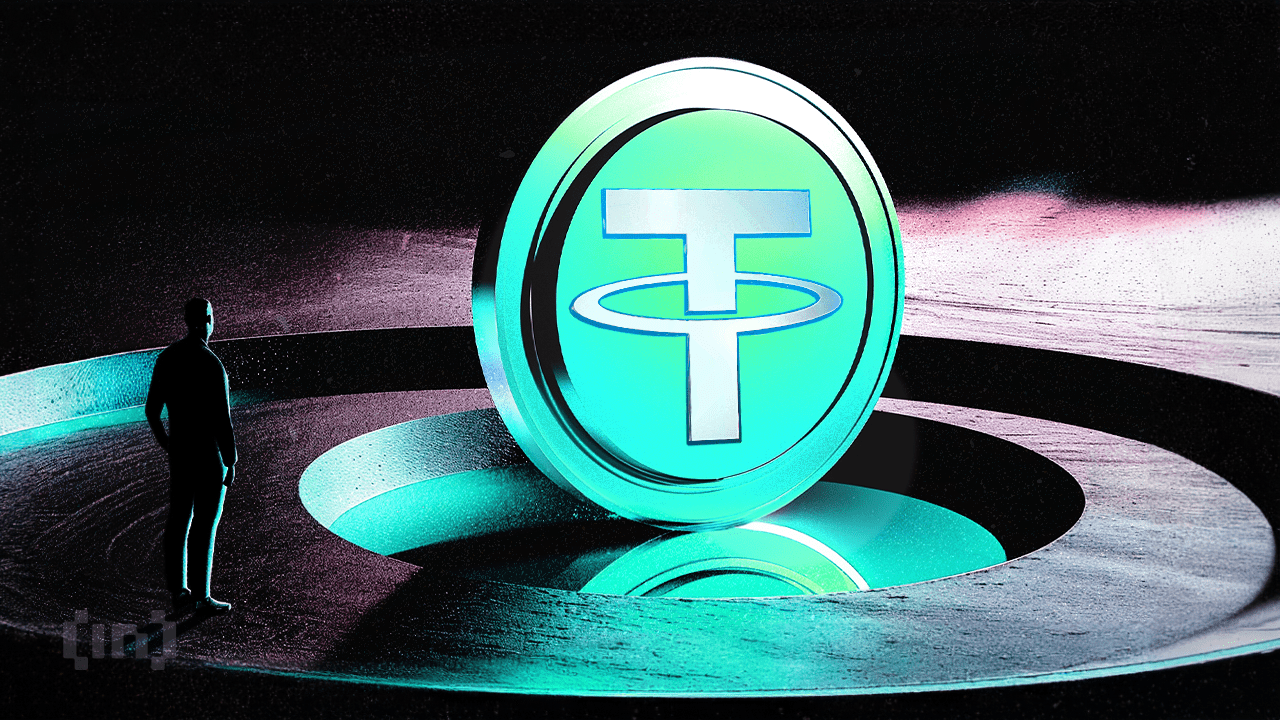

Renowned advocacy organization Consumers’ Research raised concerns about Tether, criticizing the USDT stablecoin issuer for exposing users to significant risks due to its business model.
Despite these concerns, Tether has recently emerged as one of the most profitable crypto companies globally, reporting massive quarterly profits.
Consumers’ Research Slams Tether for Audit Risks
In a letter aimed at protecting consumers, addressed to Washington Governor Jay Inslee, Consumers’ Research criticized Tether for failing to conduct an audit to prove that its USDT stablecoin is backed 1:1 by the US dollar, despite promises dating back nearly 10 years.
The report described this failure as a serious risk, calling Tether and USDT a “disaster for consumers waiting to happen.”
“Tether’s continual failure to undergo an independent audit raises a distressing red flag for the company and its USDT product. Tether has promised that it would conduct a full audit since at least 2017 but has still failed to do so. In August 2022, its CEO stated that an audit was ‘likely months away.’ Years later, there is still no audit,” read a paragraph in the letter.
In addition to the lack of audits, Consumers’ Research criticized Tether for its history of doing business with bad actors, including sanctioned crypto exchanges like Garantex and BitPapa. The report also referenced a recent Wall Street Journal (WSJ) article, which accused Tether of “enabling a parallel economy that operates beyond the reach of US law enforcement.”
Read more: 9 Best Crypto Wallets to Store Tether (USDT)
The Consumers’ Research also detailed Tether’s “history of false claims,” mentioning key red flags, including but not limited to:
- In 2018, the US Department of Justice investigated Tether and Bitfinex’s involvement in crypto market manipulation.
- In 2019, New York determined that Tether moved hundreds of millions of dollars to conceal the loss of $850 million in client money.
- In 2021, Tether ceased trading activity in New York and paid $18.5 million in penalties.
- In 2022, Tether settled charges stemming from false statements allegedly made regarding its backing of USDT with US dollars with the Commodity Futures Trading Commission (CFTC).
- Also, in 2022, the SEC fined the law firm that claimed the US dollar-backed USDT for improper accounting purposes.
These reports, which raise concerns about Tether’s financial safeguards, accuse the firm of undermining America’s efforts to fight illicit entities.
“Tether has many of the same issues that FTX and Celsius had before their collapse – potentially costing consumers billions of dollars using deceptive and misleading marketing tactics that are inconsistent with the truth,” the report concluded.
Amidst these claims, it is worth mentioning that Tether is collaborating with Tron and TRM Labs to combat USDT criminal activity.
Tether Relies on Attestations for its Reserves
Tether CEO Paolo Ardoino stated in an April interview that the company relies on attestations for its reserves. He also revealed that Tether is seeking an auditor from among the top global accounting firms. However, the Big Four — Deloitte, PwC, EY, and KPMG — are reportedly hesitant, fearing potential damage to their reputations.
“So you are a Big Four auditing firm, and you have the entire banking industry that is your customer. Why would you risk 100,000 customers for a couple of stablecoins? Between the FTX disaster and the hacks, heists, and regulatory crackdowns in crypto, it hasn’t been easy to sign on as a client for one of those top accounting outfits,” Ardoino said.
Despite these concerns, Tether remains highly profitable. A recent report revealed that Tether outperformed BlackRock, with earnings of $6.2 billion compared to the asset manager’s $5.5 billion.
“How is it possible that a stablecoin issuer with around 100 employees made more money than the largest mutual fund company in 2023? You give them dollars. They give you Tether tokens, which are essentially entries on the blockchain. They use your dollars to buy US bonds yielding 5%. They use the yield to buy Bitcoin for their balance sheet. You do not need many people to do this, and it is an extremely profitable business model. Now you understand why BlackRock has taken an interest in crypto,” crypto analyst Frederik Lund explained.
Read more: A Guide to the Best Stablecoins in 2024
Indeed, Tether’s profits are bolstered by income from US Treasuries and mark-to-market gains on its Bitcoin and gold holdings, according to a recent blog post, which suggests these factors inflate the company’s financials. A quarterly attestation showed $118.44 billion backing Tether-related stablecoins — over $5 billion more than the circulating supply — indicating the stablecoins are fully backed by reserves.
In a recent legal victory, a UK court ruled that Tether’s USDT stablecoin qualifies as property. This decision, made by the High Court Justice for England and Wales, follows the UK Parliament’s move to recognize crypto, NFTs, and carbon credits as personal property under British law.
Disclaimer
In adherence to the Trust Project guidelines, BeInCrypto is committed to unbiased, transparent reporting. This news article aims to provide accurate, timely information. However, readers are advised to verify facts independently and consult with a professional before making any decisions based on this content. Please note that our Terms and Conditions, Privacy Policy, and Disclaimers have been updated.
Market
This is Why PumpSwap Brings Pump.fun To the Next Level

Since launching PumpSwap, token launchpad Pump.fun has resumed its position as a top-level protocol by fees and revenue. It saw over $2.62 billion in volume in less than two weeks, signifying high market interest.
Nonetheless, the meme coin sector as a whole has been more volatile than usual lately. PumpSwap is an attractive new option, but it still needs to stand the test of time.
Pump.fun Surges with PumpSwap
Pump.fun, a prominent meme coin creation platform, recently suffered some difficulties in the market. Facing lawsuits and criticism from the industry, the platform’s revenue had been declining in 2025. However, since launching PumpSwap, Pump.fun’s income has rebounded, making it one of the largest protocols by fees and revenue.

PumpSwap is a decentralized exchange on Solana’s blockchain, and it has grown very quickly since its launch less than two weeks ago. It has already managed over $2.62 billion in trade volume, although its daily volume fell over the weekend. Pump.fun’s cofounder spoke highly about PumpSwap, calling it a “crucial step that will help grow the ecosystem.”
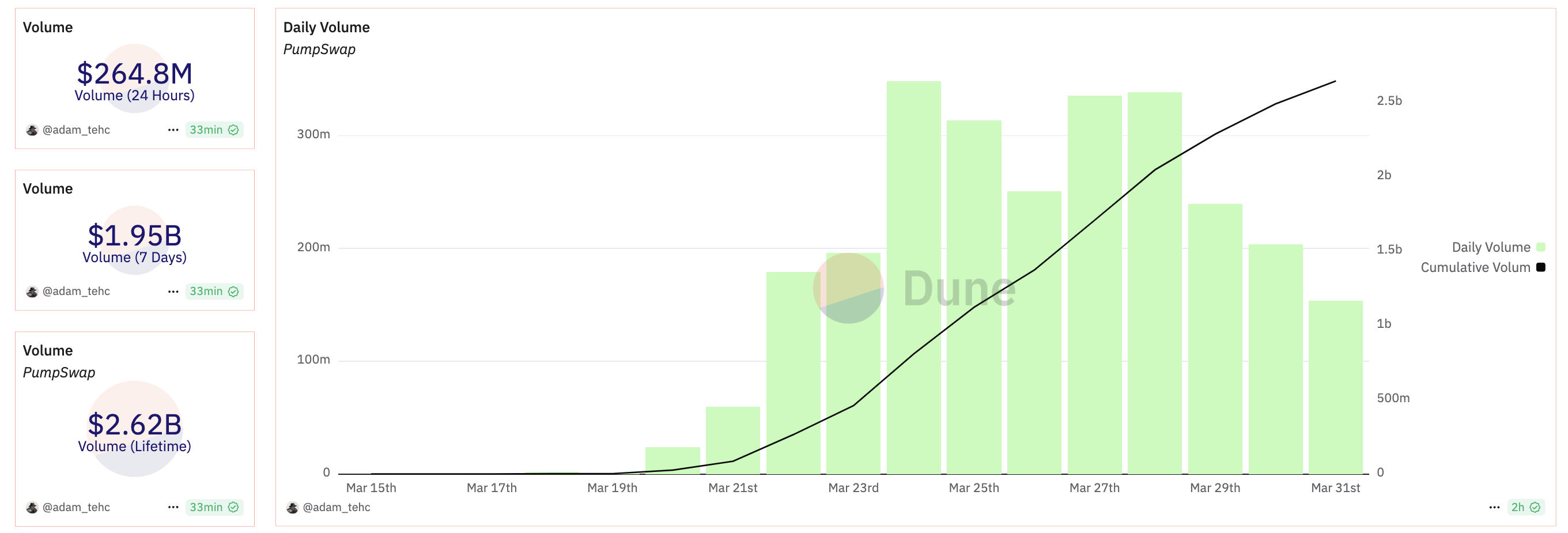
Pump.fun’s overall revenues were declining before it launched PumpSwap, and they have since jumped back up. However, it’s important to not overstate the new exchange’s success. The exchange’s total fees collected have skyrocketed compared to Pump.fun, but the actual revenue growth has been comparatively small.
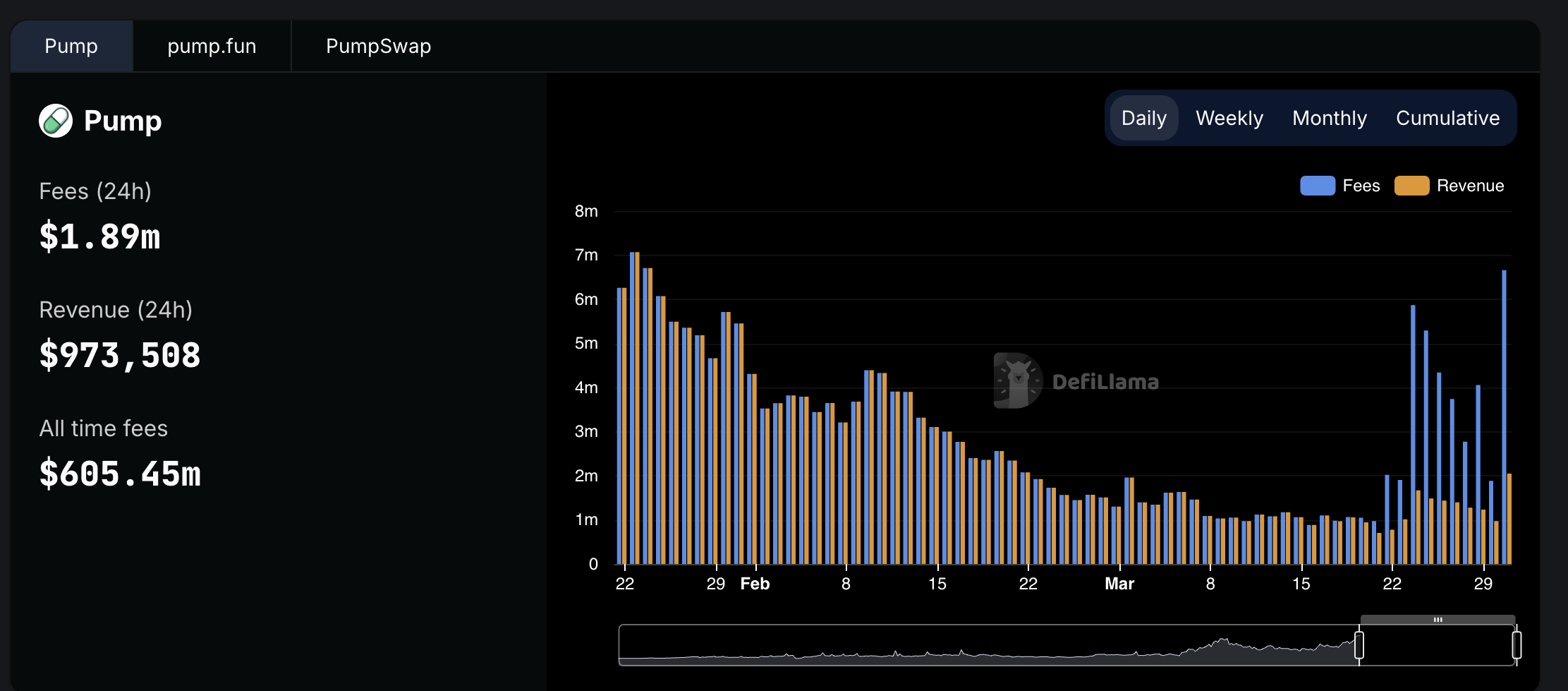
Still, these low fees also have significant advantages. Demand seems to be drying up in the meme coin sector, but Pump.fun faces stiff competition in the form of firms like Raydium, using low fees as a competitive edge. It has also promised things like revenue sharing with token creators to promote ecosystem growth.
Ultimately, the meme coin market as a whole is full of uncertainty. PumpSwap has been able to keep Pump.fun competitive as a top-level platform in this space, giving it a welcome reprieve. The real challenge will come in determining long-term viability.
Disclaimer
In adherence to the Trust Project guidelines, BeInCrypto is committed to unbiased, transparent reporting. This news article aims to provide accurate, timely information. However, readers are advised to verify facts independently and consult with a professional before making any decisions based on this content. Please note that our Terms and Conditions, Privacy Policy, and Disclaimers have been updated.
Market
Hedera (HBAR) Bears Dominate, HBAR Eyes Key $0.15 Level

Hedera (HBAR) is under pressure, down roughly 13.5% over the past seven days, with its market cap holding at around $7 billion. Recent technical signals point to growing bearish momentum, with both trend and momentum indicators leaning heavily negative.
The price has been hovering near a critical support zone, raising the risk of a breakdown below $0.15 for the first time in months. Unless bulls regain control soon, HBAR could face further losses before any meaningful recovery attempt.
HBAR BBTrend Has Been Turning Heavily Down Since Yesterday
Hedera’s BBTrend indicator has dropped sharply to -10.1, falling from 2.59 just a day ago. This rapid decline signals a strong shift in momentum and suggests that HBAR is experiencing an aggressive downside move.
Such a steep drop often reflects a sudden increase in selling pressure, which can quickly change the asset’s short-term outlook.
The BBTrend, or Bollinger Band Trend, measures the strength and direction of a trend using the position of price relative to the Bollinger Bands. Positive values generally indicate bullish momentum, while negative values point to bearish momentum.

The further the value is from zero, the stronger the trend. HBAR’s BBTrend is now at -10.1, signaling strong bearish momentum.
This suggests that the price is trending lower and doing so with increasing strength, which could lead to further downside unless buyers step in to slow the momentum.
Hedera Ichimoku Cloud Paints a Bearish Picture
Hedera’s Ichimoku Cloud chart reflects a strong bearish structure, with the price action positioned well below both the blue conversion line (Tenkan-sen) and the red baseline (Kijun-sen).
This setup indicates that short-term momentum is clearly aligned with the longer-term downtrend.
The price has consistently failed to break above these dynamic resistance levels, signaling continued seller dominance.
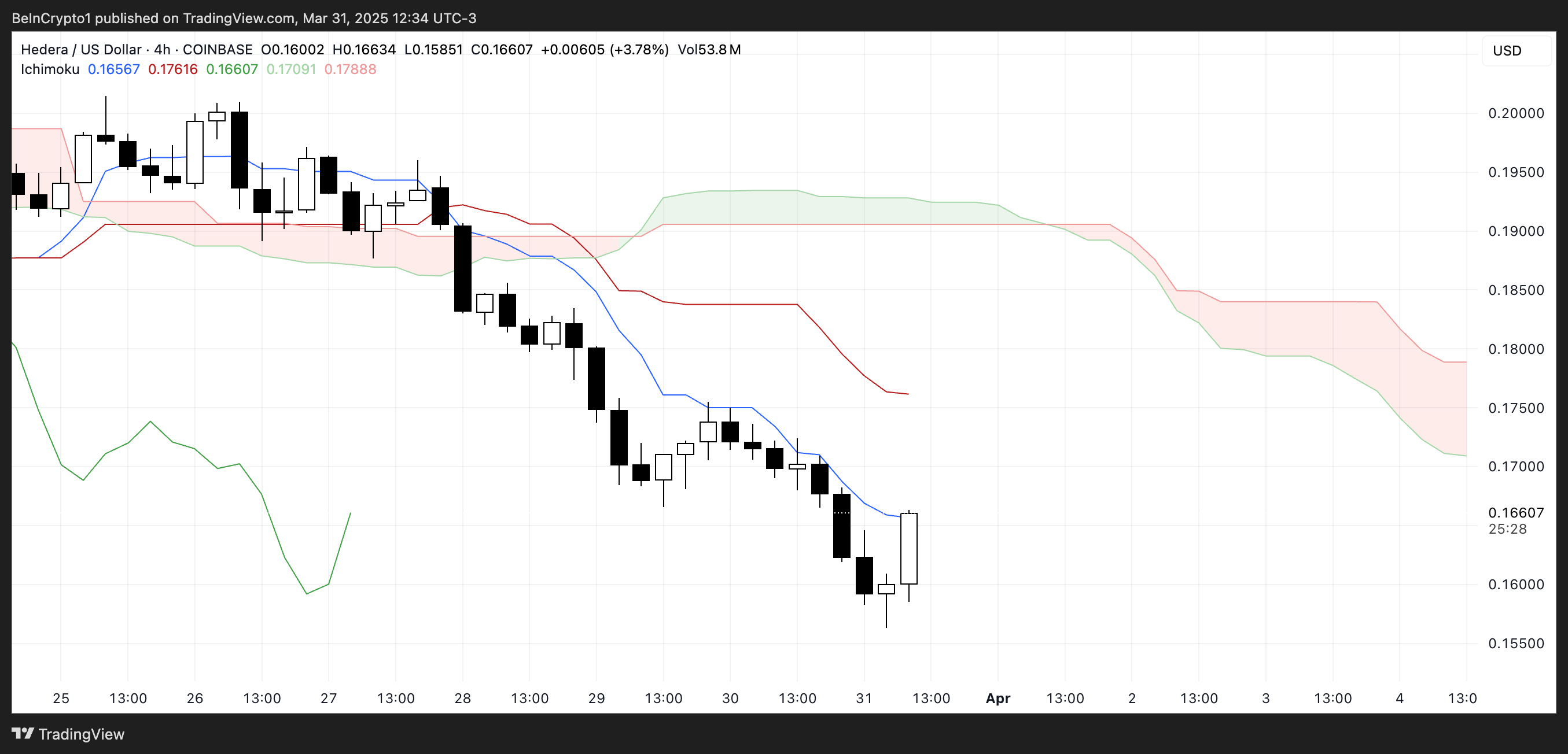
The future cloud is also red and trending downward, suggesting that bearish pressure is expected to persist in the near term.
The span between the Senkou Span A and B lines remains wide, reinforcing the strength of the downtrend. For any potential reversal to gain credibility, HBAR would first need to challenge and break above the Tenkan-sen and Kijun-sen, and eventually push into or above the cloud.
Until then, the current Ichimoku configuration supports a continuation of the bearish outlook.
Can Hedera Fall Below $0.15 Soon?
Hedera price has been hovering around the $0.16 level and is approaching a key support at $0.156.
If this support fails to hold, it could open the door for further downside, potentially pushing HBAR below the $0.15 mark for the first time since November 2024.
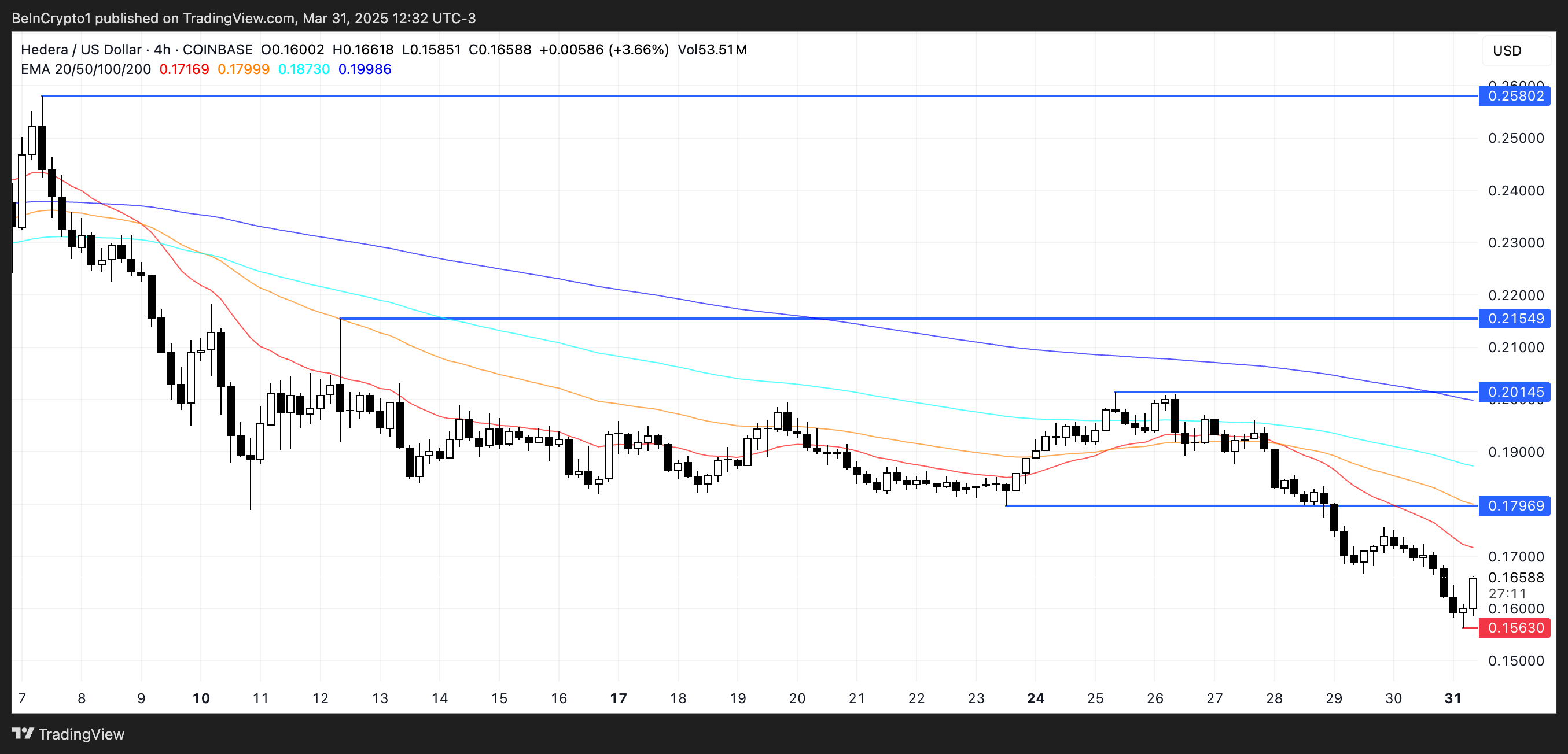
However, if HBAR manages to reverse its current trajectory and regain bullish momentum, the first target to watch is the resistance at $0.179.
A breakout above that level could lead to a stronger rally toward $0.20 and, if momentum continues, even reach $0.215. In a more extended bullish scenario, HBAR could climb to $0.25, signaling a full recovery and trend reversal.
Disclaimer
In line with the Trust Project guidelines, this price analysis article is for informational purposes only and should not be considered financial or investment advice. BeInCrypto is committed to accurate, unbiased reporting, but market conditions are subject to change without notice. Always conduct your own research and consult with a professional before making any financial decisions. Please note that our Terms and Conditions, Privacy Policy, and Disclaimers have been updated.
Market
Coinbase Tries to Resume Lawsuit Against the FDIC


Coinbase asked a DC District Court if it could resume its old lawsuit against the FDIC. Coinbase sued this regulator over Operation Choke Point 2.0 and claimed that it’s still refusing to release relevant information.
Based on the information available so far, it’s difficult to draw definitive conclusions. The FDIC maintains that it responded to its opponents’ questions truthfully, though it has shown delays in the past.
Coinbase vs the FDIC
Coinbase, one of the world’s largest crypto exchanges, has been in a few fights with the FDIC. The firm has been pursuing the FDIC over Operation Choke Point 2.0 for months now, and has achieved impressive results. Despite this, however, Coinbase is asking the DC District Court to resume its litigation against the regulator:
“We’re asking the Court to resume our lawsuit because the FDIC has unfortunately stopped sharing information. While we would have loved to resolve this outside of the legal system – and we do appreciate the increased cooperation we’ve seen from the new FDIC leadership – we still have a ways to go,” claimed Paul Grewal, Coinbase’s Chief Legal Officer.
The FDIC has an important role in US financial regulation, primarily dealing with banks. This gave it a starring role in Operation Choke Point 2.0, hampering banks’ ability to deal with crypto businesses. However, it recently started a pro-crypto turn, releasing tranches of incriminating documents and revoking several of its anti-crypto statutes.
Grewal said that he “appreciated the increased cooperation” from the FDIC but that the cooperation stopped weeks ago. According to Coinbase’s filing, the FDIC hasn’t sent any new information since late February and claimed in early March that the exchange’s subsequent requests were “unreasonable and beyond the scope of discovery.”
On one hand, the FDIC has previously been slow to make relevant disclosures in the Coinbase lawsuit. On the other hand, Operation Choke Point 2.0 sparked significant tension within the industry, and a determined group is now aiming to significantly weaken the regulatory bodies involved.
Until the legal battle continues, it’ll be difficult to make any definitive statements. The FDIC will likely have two weeks to respond to Coinbase’s request.
Disclaimer
In adherence to the Trust Project guidelines, BeInCrypto is committed to unbiased, transparent reporting. This news article aims to provide accurate, timely information. However, readers are advised to verify facts independently and consult with a professional before making any decisions based on this content. Please note that our Terms and Conditions, Privacy Policy, and Disclaimers have been updated.
-

 Market21 hours ago
Market21 hours agoBitcoin Bears Tighten Grip—Where’s the Next Support?
-

 Market20 hours ago
Market20 hours agoEthereum Price Weakens—Can Bulls Prevent a Major Breakdown?
-

 Market15 hours ago
Market15 hours agoDon’t Fall for These Common Crypto Scams
-

 Ethereum8 hours ago
Ethereum8 hours agoEthereum Price Confirms Breakout From Ascending Triangle, Target Set At $7,800
-
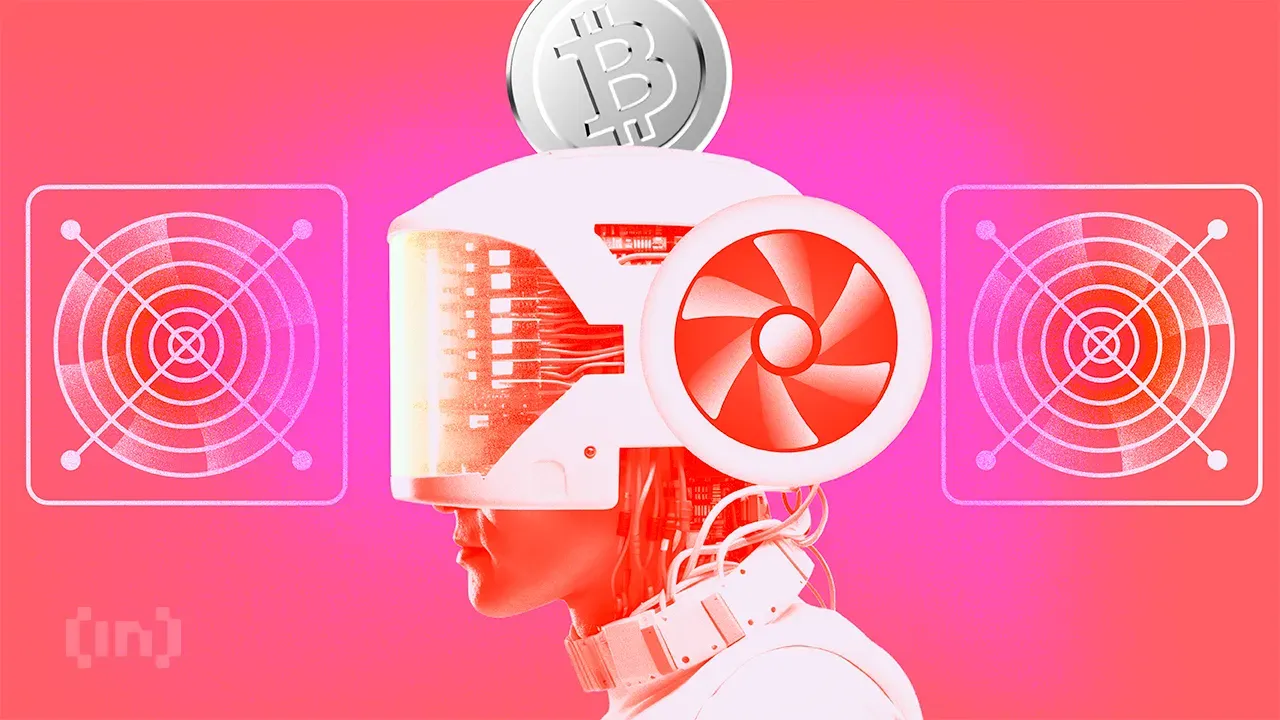
 Bitcoin13 hours ago
Bitcoin13 hours agoMarathon Digital to Sell $2 Billion in Stock to Buy Bitcoin
-

 Bitcoin8 hours ago
Bitcoin8 hours agoStrategy Adds 22,048 BTC for Nearly $2 Billion
-

 Market13 hours ago
Market13 hours agoStrategic Move for Trump Family in Crypto
-
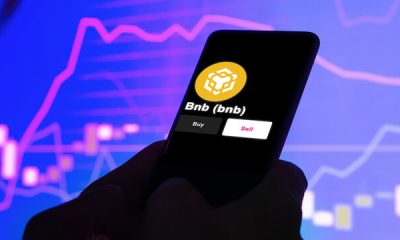
 Market8 hours ago
Market8 hours agoBNB Breaks Below $605 As Bullish Momentum Fades – What’s Next?























